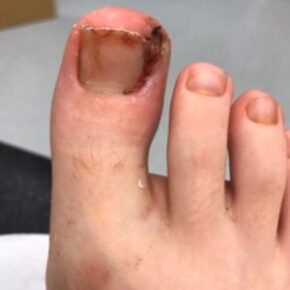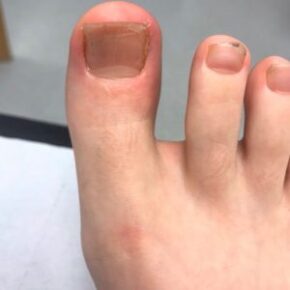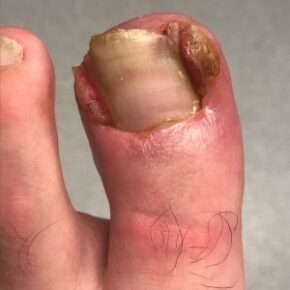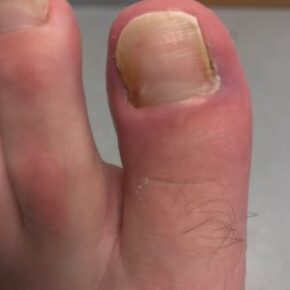Ingrowing toenails are commonly caused by the following:
- Incorrect nail cutting.
- Tight footwear and hosiery.
- Direct trauma.
- Underlying biomechanical condition.
An ingrown toenail happens when the edge of the nail pushes into the surrounding skin, causing redness, swelling, and tenderness. If left untreated for several weeks or months, the area can become infected and develop a type of soft, overgrown tissue called hypergranulation.
This tissue forms as a reaction to the nail pressing into the skin and often builds up under and around the affected area. Because it contains many blood vessels, even a light touch to the toe can be very painful and may cause bleeding.
In more serious cases, the toe may become infected and start to release pus. Patients are often prescribed repeated courses of antibiotics to manage the infection and swelling. However, antibiotics do not treat the actual cause, the nail itself, and won’t prevent the problem from continuing.
We offer three main types of procedures to treat ingrown toenails. The most suitable option is chosen based on each patient’s specific needs. Our goal is to fully resolve the issue while ensuring a good cosmetic outcome.
There are 3 common procedures we practice for performing ingrowing toenail surgery under local anaesthesia.
Partial Nail Avulsion (PNA)
This is the most commonly performed procedure. It involves removing only the section of the nail that’s causing the problem, leaving the rest of the nail intact. It’s carried out under local anaesthetic and has a success rate of over 98%.
Two small injections are given at the base of the toe to numb the area. The anaesthetic takes around 5–10 minutes to work and can last for up to 4 hours. During the procedure, you won’t feel pain, though you may feel pressure or touch.
To reduce bleeding, a small tourniquet is applied to the toe. If there is any overgrown tissue (hypergranulation), this will be removed before the nail section is taken out.
Once the problematic part of the nail is removed, a chemical called phenol is applied to the nail bed to stop it from growing back. This step takes no longer than 3 minutes and is important to prevent the nail from regrowing.
The procedure itself takes about 15–20 minutes. Afterward, you’ll rest with your foot elevated for another 15 minutes while we check the dressings before you’re discharged.
Most people recover within 2–3 weeks and usually don’t need time off work or school.

Before Ingrowing Nail Surgery 
After 
Before Ingrowing Nail Surgery 
After
Winograd’s procedure
Involves surgically removing both the nail plate and the corresponding nail bed. Sutures hold the wound together whilst healing takes place. These are removed after 10 – 14 days. This procedure is generally used to promote rapid healing in those patients who present with a systemic health issue e.g Diabetes
What to expect after surgery
Most patients report very little or no pain after their operation, we advise that you take pain relief medication when you arrive home e.g Paracetamol.
Most patients report very little or no bleeding after their operation. Those patients who have been prescribed Warfarin are advised to stop 24 hours prior to their procedure. As post – operative dressings are small in size, patients are able to return home in normal footwear, some patients prefer to bring an open toe sandal or slipper.
We advise that you rest with your operative foot elevated for a couple of hours when you return home. The local anaesthetic usually takes a couple of hours to wear off. Patients are advised not to bathe for 24 hours following their operation.
Patients require no time off work or school the following day after your procedure. Patients are seen for their first redressing appointment the following day, then advised how to dress their toe daily with sterile dressings that we provide, should patients encounter any post-operative problems a 24 hour Podiatry on call service is available.
Patients are seen weekly by the same Podiatrist until their wound is completely healed and then discharged.
Driving a motor vehicle
Most patients are able to drive the day after their operation, although we recommend when you feel comfortable and confident to perform an emergency stop in your vehicle.
Returning to sport
We advise that you wait until your wound is completely healed before returning to any sporting activity.
Time off work or school
As this is a minor procedure, patients can return the following day to work or school.
